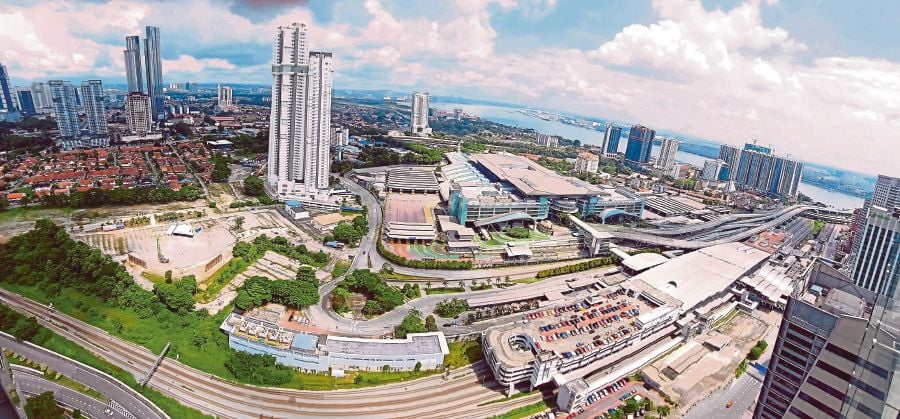KUALA LUMPUR: Stakeholders have praised the Johor Bahru-Singapore Rapid Transit System (RTS) Link and the construction of a brand-new urban oasis adjacent to the RTS Link station in Johor Bahru as game-changers.
Using a "rail plus property" model, this urban oasis will provide premium educational facilities, healthcare and wellness services, and hospitality offerings.
Industry observers predict that the RTS will bring about significant changes to the Johor Bahru (JB) property market, with benefits for homes, businesses, retail, leisure, and lodging.
According to them, property values in some parts of JB are beginning to increase ahead of the RTS project's completion by the end of 2026.
"The Johor real estate market is currently seeing a lot of buying interest. High-rise apartments in desirable areas, especially in the Johor Bahru city centre and Iskandar Malaysia region, are being bought by Singaporeans looking for vacation or investment properties as well as by Malaysians who work in Singapore," they said.
Purchasers of real estate near the Bukit Chagar station, which is being developed next to the existing immigration complex in JB, seem to be broadly in agreement with this optimism.
"We have been renting for the past eight years now, and we feel it is time we take it a step further by owning our own home, as we believe it would reap good potential as the years go by," Johorean Fatimah Ahmad said.
She told NST Property that since late 2022, the rents and real estate values in her neighbourhood—which is near Bukit Chagar—have improved.
"With the overnight policy rate remaining at 3.0 per cent, now is a favourable time to purchase. Additionally, developers are offering greater incentives, and the gross domestic product of the country might grow the following year," she said.
According to iProperty.com.my's top 10 most searched areas by homebuyers in Malaysia this year, Johor Bahru secured the third spot, one position higher than in 2022.
The number of property transactions in Johor Bahru is on the rise as property seekers hunt for deals ahead of the opening of the RTS, it said.
Additionally, the move to ease the conditions of the Malaysia My Second Home (MM2H) programme, coupled with the rise in rental costs in Singapore, could further boost the sale of properties in Johor.
The top three transacted properties in Johor Bahru are Taman Johor Jaya, Country Garden Danga Bay, and Taman Pelangi.
One of the most searched properties this year is Trellis Residences (521.6 per cent), which is situated at the intersection of major roads and near the CIQ complex, JB Sentral, and the Bukit Chagar RTS Link station, offering a direct link to Singapore.
Meanwhile, some developers have noted a greater response to their launches.
The Astaka @ One Bukit Senyum, the premier residential development by Astaka Holdings Ltd, sold 70 per cent of the apartments to buyers from 15 different countries, including Singapore, Indonesia, China, Hong Kong, Japan, Korea, Germany, Brunei, and Finland.
The Johor developer is making a comeback to the real estate development scene following a brief break with the upcoming Aliva Mount Austin residential project in Mount Austin, Johor Bahru.
Aliva, which has 499 units and an estimated gross development value (GDV) of RM254 million, should be completed by the end of 2026.
Chinese developer R&F reportedly said it saw five times as many transactions for its R&F Princess Cove serviced apartments in Johor Bahru between April and September this year, in comparison to the same period in 2022. Buyers from Singapore comprise 40 per cent of the total, with Malaysia, China, and Taiwan following closely behind.
When R&F launched its second phase of sales for Princess Cove in 2018, it sold an estimated 30 per cent of the nearly 3,800 apartments by the end of the year.
But sales were affected in the following year because of Covid-19 which forced the closure of international borders, including the land crossings between Johor and Singapore.
However, this year, thanks to the RTS's advancement, sales for the project shot up, particularly from April to September.

When the RM10 billion RTS is completed in 2026, it will be a significant link between the two countries. It will span 4 km.
Prior to the first soil being turned in 2020, the project—which was first announced in 2010—saw several delays.
Prime Minister Datuk Seri Anwar Ibrahim and Singapore's Prime Minister Lee Hsien Loong expressed confidence during the 10th Singapore-Malaysia Leaders' Retreat held in October that the project is on track to be completed by the end of 2026.
Construction of the rail link, which began in November 2020, crossed the 50 per cent mark on both sides in November 2023.
The completion of the drop-in span that will link the RTS Link's viaduct across the Strait of Johor will be celebrated with a ceremony in early 2024.
Traffic congestion on the Causeway, which has long frustrated hundreds of thousands of daily commuters and day-trippers, is predicted to improve with the introduction of the rail shuttle service.
The above-ground Bukit Chagar terminus, which is close to the JB checkpoint, will be the starting point for the four-carriage RTS link train's journey to Singapore's underground Woodlands North station.
At an approximate speed of 80 km/h, it will complete the trip in six minutes. Train frequency during peak hours is anticipated at 3.6 minutes.





